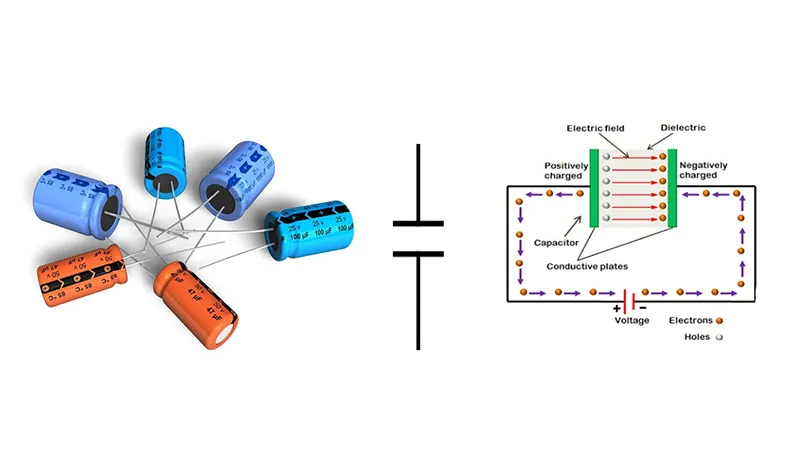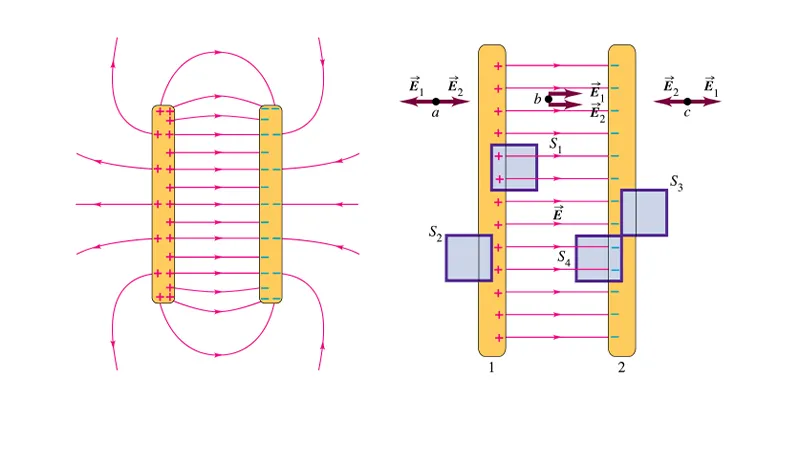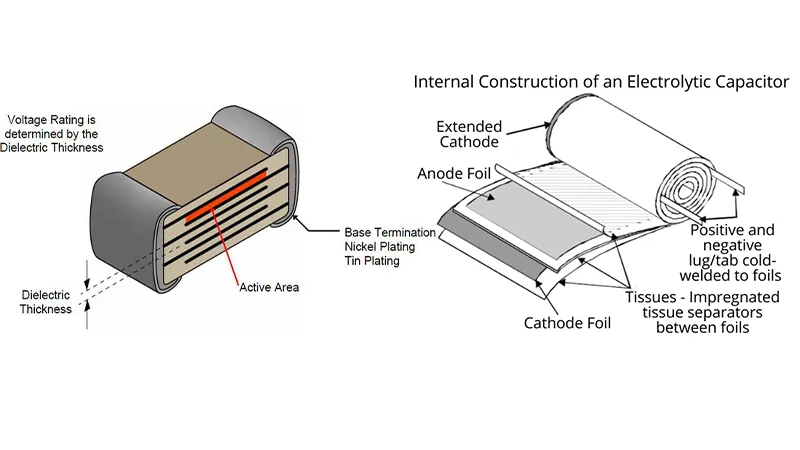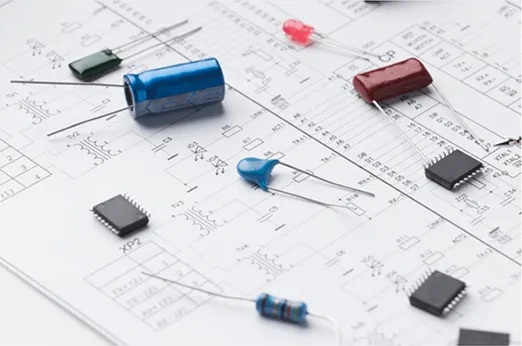Capacitors are fundamental components in electronic circuits, essential for storing and releasing electrical energy. They are ubiquitous in various applications, from simple circuits to complex electronic devices. Despite their prevalence, the inner workings of capacitors remain a mystery to many.
In this comprehensive exploration, we’ll delve deep into the intricate mechanisms that govern capacitors, examining the electric and magnetic fields inside them, their materials, and how they operate.
How Capacitors Work

At the heart of every capacitor lies a simple yet ingenious principle: the accumulation and separation of electric charge. A capacitor consists of two conductive plates separated by a dielectric material.
When a voltage is applied across the plates, electrons accumulate on one plate, creating a negative charge, while an equal number of electrons are depleted from the other plate, resulting in a positive charge. This charge separation generates an electric field between the plates, which stores energy in the capacitor.
Charge Storage Mechanism
The ability of a capacitor to store charge is quantified by its capacitance, measured in farads (F). The capacitance depends on three main factors:
- Surface Area of the Plates: Larger surface areas allow more charge to be stored.
- Distance Between the Plates: Smaller distances between the plates increase capacitance.
- Dielectric Material: The material’s dielectric constant between the plates affects how much charge can be stored.
Mathematically, capacitance (C) can be expressed as:
where 𝜖 is the permittivity of the dielectric material, 𝐴 is the surface area of the plates, and 𝑑 is the distance between the plates.
Energy Storage
The formula gives the energy (E) stored in a capacitor:
where 𝐶 is the capacitance and 𝑉 is the voltage applied across the plates. This relationship highlights how capacitors store energy in the electric field created between their plates.
Electric Field Inside a Capacitor

The electric field inside a capacitor is central to its operation. It is strongest between the plates and decreases with distance from the plates. The electric field is directly proportional to the applied voltage and inversely proportional to the distance between the plates, following the formula:
where 𝐸E represents the electric field strength, 𝑉V denotes the applied voltage, and 𝑑d signifies the distance between the plates. This relationship is crucial for understanding how capacitors function and how they store energy.
Electric Field Inside a Parallel Plate Capacitor
In a parallel plate capacitor, the electric field is uniform between the plates. This uniformity simplifies calculations and makes parallel plate capacitors ideal for theoretical studies and practical applications. The electric potential inside a parallel plate capacitor varies linearly from one plate to the other, facilitating a predictable and stable energy storage mechanism.
Electric Potential Inside a Capacitor
The electric potential, or voltage, within a capacitor, represents the potential energy per unit charge at a given point between the plates. The potential difference between the plates drives the flow of charge, enabling the capacitor to store and release energy efficiently. Understanding the distribution of electric potential inside a capacitor is key to designing and optimizing capacitor-based circuits.
Different Types of Capacitors and Their Internal Configurations
Capacitors come in various types, each with unique construction and characteristics tailored to specific applications. Let’s explore some common types of capacitors and unravel the secrets concealed within their casings.
Ceramic capacitors are widely used due to their stability and reliability. They use ceramic as the dielectric material, offering a high dielectric constant, which allows for efficient energy storage in a small footprint. Inside a ceramic capacitor, the electric field remains confined within the dielectric material, contributing to its overall capacitance and performance.
Electrolytic capacitors are known for their high capacitance values, making them suitable for applications requiring significant energy storage. They utilize an electrolyte, typically a liquid or gel-like substance, between the conductive plates. The electric field inside an electrolytic capacitor interacts with the electrolyte, influencing its behavior and performance. This interaction enhances the capacitance but also introduces polarity, meaning they must be connected correctly in a circuit.
Film capacitors employ a thin film of dielectric material, such as polyester or polypropylene, to separate the conductive plates. The electric field inside a film capacitor is evenly distributed across the dielectric, ensuring uniform energy storage and release. These capacitors are valued for their stability, low inductance, and low dielectric absorption, making them ideal for high-frequency applications.
Magnetic Field Inside a Capacitor
While the electric field is the primary force at play in capacitors, a magnetic field is also present, albeit weaker. According to Maxwell’s equations, a changing electric field induces a magnetic field. In capacitors, the movement of charge carriers generates a magnetic field, contributing to the overall energy dynamics within the device.
The magnetic field inside a capacitor is primarily generated by the movement of charge carriers, such as electrons, in response to applied voltage. This magnetic field, though weaker compared to the electric field, plays a role in the electromagnetic interactions within the capacitor.
What Metal is Inside a Capacitor?

The metal used in capacitors varies depending on the type and application of the capacitor.
In ceramic capacitors, the plates are often made of metalized ceramic materials, such as silver palladium. These materials offer excellent conductivity and stability, ensuring reliable performance across a wide range of temperatures and frequencies.
Electrolytic capacitors typically use aluminum for the plates due to its high conductivity, affordability, and ease of manufacturing. The aluminum plates are etched to increase the surface area, thereby enhancing the capacitance. The electrolyte also contributes to the overall capacitance and stability of the capacitor.
Film capacitors may use various metals for the plates, including aluminum, zinc, or copper, depending on the specific requirements of the application. These metals provide the necessary conductivity while being compatible with the dielectric films used in these capacitors.
How Capacitors Work in Different Applications
Capacitors are versatile components used in a wide range of applications. Understanding how they work in different contexts can provide deeper insights into their functionality and importance.

Power Supply Smoothing
In power supply circuits, capacitors are used to smooth out voltage fluctuations. They store energy when the supply voltage is higher than the desired output and release it when the supply voltage drops, ensuring a stable and consistent output.
Signal Filtering
Capacitors are essential in filtering applications, where they block direct current (DC) while allowing alternating current (AC) to pass. This property makes them invaluable in audio and radio frequency (RF) circuits, where they help filter out unwanted noise and signals.
Timing Circuits
In timing circuits, capacitors are used in conjunction with resistors to create time delays. The charging and discharging cycles of the capacitor determine the timing intervals, which are crucial in applications like oscillators and pulse generators.
Energy Storage
Capacitors are also used for energy storage in various applications, from flash photography to electric vehicles. They can quickly charge and discharge, providing bursts of energy when needed. This capability makes them ideal for applications requiring rapid energy delivery.
Special Capacitor Configurations
Super Capacitors
Supercapacitors, also known as ultracapacitors, are a special type of capacitor with very high capacitance values. They use advanced materials like activated carbon and graphene to achieve capacitance values far beyond traditional capacitors. Supercapacitors are used in applications requiring high energy density and rapid charge-discharge cycles, such as regenerative braking systems in electric vehicles.
AC Capacitors
AC capacitors are specifically designed for alternating current applications. They are commonly used in motors, air conditioners, and power factor correction circuits. Inside AC capacitors, the dielectric material and the metal plates are optimized to handle the AC voltage, ensuring reliable performance over extended periods.
Variable Capacitors
Variable capacitors allow for adjustable capacitance values. They are used in tuning circuits, such as those found in radios, where precise control over capacitance is necessary for frequency selection. The internal structure of variable capacitors includes movable plates or adjustable dielectric materials to vary the capacitance as needed.
Conclusion
Capacitors are intricate devices that rely on the interplay of electric and magnetic fields to store and release electrical energy. Understanding the electric field inside a capacitor, along with its construction and materials, is essential for designing efficient and reliable electronic circuits.
From ceramic and electrolytic capacitors to advanced supercapacitors, each type offers unique insights into the fascinating world of electrical energy storage.
By demystifying the inner workings of capacitors, we gain a deeper appreciation for their role in modern technology and innovation, paving the way for further advancements in electronic design and application.